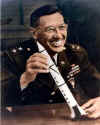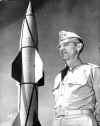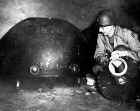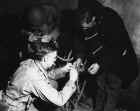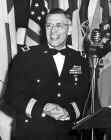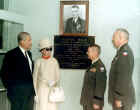Table of contents:
Read a paper written by a West Point classmate about Toftoy
View photos of Major General Holger N. Toftoy
Major General Holger N. Toftoy
Major General Holger Nelson Toftoy was born on 31 October 1902, in Marseilles, Illinois. He began his military service as an ROTC cadet at the University of Wisconsin in 1920. During his second year there, he was appointed to the U.S. Military Academy and was graduated in 1926. After taking basic flight training, he transferred to the Coast Artillery and served three years in Hawaii as a battery commander before returning to West Point as an instructor for five years.
In the mid-l930s he was assigned to command the mine defenses of the Pacific approaches of the Panama Canal. In 1938 he was transferred to the Submarine Mine Depot, Fort Monroe, where he served for six years as Chief of the Industrial and the Research and Development Divisions. He directed the design and development of a new type of controlled submarine mine system widely used in World War II.
Toftoy knew the U.S. Army was planning to add guided missiles to its weapons program. He first cabled, then went personally to Washington to recommend that the German scientists be brought to the U.S. for interrogation and possible employment. By September 1945, the first group of scientists, including von Braun, had arrived in the U.S. Toftoy was then transferred back to Washington and assigned responsibility for direction of the Army guided missile program.
In 1952, Toftoy was assigned to Redstone Arsenal, Alabama, as Director of the Ordnance Missile Laboratories, which was responsible for planning, technical control and supervision of what had become the nation-wide Army guided missile and rocket development program.
Within two years, Redstone Arsenal had become recognized as one of the Army's most important technical centers, and General Toftoy, first as a Brigadier General, then as Major General in command of Redstone Arsenal, had laid the foundation of today's huge complex.
During the period of his command, 1952 to August 1958, RSA became responsible for the research and development, procurement and production, storage, maintenance and issue of the entire Army family of missiles and rockets. The products of that formative period have become historic: NIKE AJAX; NIKE HERCULES; HAWK; LACROSSE; HONEST JOHN; LITTLEJOHN; CORPORAL; REDSTONE; SERGEANT; PERSHING; NIKE ZEUS; JUPITER; JUPITER C; EXPLORER; and PIONEER.
Editor's note: The following was written by a West Point classmate of General Toftoy. The author wished that he be identified only as "A Roommate." The following essay provides a personal glimpse into the career and life of MG Toftoy.
HOLGER NELSON TOFTOY
No. 7923
Class of 1926
Major General Holger Nelson Toftoy was born in Marseilles, Illinois 31 October 1902 and died in Washington, D.C., on 19 April 1967. Between these dates there lived a man respected and admired by his associates, beloved by his family and friends. During these sixty-four and one-half years "Ludy" Toftoy developed his considerable talents into abilities which have led to outstanding achievement in service to his country. Yet never could the seriousness of responsibilities nor the difficulties of current situations lessen his zest for life, his concern for others, and his love of working and living.
It is no exaggeration to say that almost everything that '26 has done during the past two years has felt the guiding hand of little Ludy.
Not all notice led to acclaim. During our first day in Beast Barracks one member of the Beast Detail misunderstood the pronunciation of "Toftoy." In explicit terms, with his neck jammed "back to infinity," Ludy learned there were no "Tough Boys" among the Plebes. The pinnacle of being the innocent bystander occurred in First Class Summer Camp. As Officer of the Day, Cadet Lieutenant Toftoy raised the uniform flags for Parade: "Full dress, fifty-fifty," and went to his tent to change uniform. In a few minutes an irate Officer-in-Charge was demanding to know why the red flag for "overcoats" and a human skull (the K-Co mascot "Oscar") were flying from the flagpole instead of the proper yellow and white flags. Innocent Ludy was soon reduced to Sergeant, while the culprits never admitted their guilt.
Commissioned in the Army Air Corps after Graduation, Ludy prepared for Primary Flying School by attending classes at the Art Students League in New York. Whether this was appropriate is questionable, for, after a few near crack-ups the Air Corps decided his flying career might be a very short one; taking the hint he asked for a transfer to the Coast Artillery Corps. Three pleasant and instructive years with his bride in Hawaii wore followed by five years as an Instructor at West Point. As a Cadet, ranking one in Drawing had been easy, so he was naturally the first of his Class to return as a member of the Drawing Department.
After attending the Battery Officers Course at Fort Monroe in 1935-36, the new Captain was assigned to the Canal Zone as commander of the Mine Battery on the Pacific side. His usual enthusiasm, curiosity, and searching for perfection were climaxed in 1938 when his Mine Battery won the Knox Trophy as the best Battery in the Coast Artillery, the first Mine Battery ever selected, The same year, Ludy was awarded the medal of Distinguished Pistol Shot. Recognition of his knowledge of submarine mines led to his assignment in 1938 to the Submarine Mine Depot at Fort Monroe. This was Toftoy's introduction to Research and Development; his was the responsibility to design and develop a controlled submarine mine system which would permit passage by friendly ships, yet allow firing of any or all of as many as nineteen mines in a single field. And then he was charged with supervising the production of all the necessary components during his tour of duty from 1938 to 1944.
In 1942-43, in addition to his duties with the Mine Depot, Ludy somehow was able to complete courses at the Command and General Staff School, the Ordnance School, and the Army-Navy Staff College. He had always had the knack of finding time to do just a little bit more, while still accomplishing his major responsibilities in an outstanding manner,
An urgent request for V-2 rockets was impossible to fulfill because each one had been fired as soon as assembled, tested, and declared ready. Then came an unbelievable stroke of luck: advancing American troops had discovered a V-2 factory in a salt mine, with a huge supply of components. In reply to his cable enquiring for an expression of interest, the War Department requested enough parts to assemble one hundred missiles. Overlooking his directive that all technologically advanced materials were to be held "intact" for disposal by Allied representatives, Toftoy ordered all the components packed and shipped to the United States. None were to be shipped to the British, another violation of his instructions. Extreme urgency and frantic efforts completed the job in time, for the factory was in the zone soon to be occupied by the Russians. Sixteen shiploads of components were sent to the United States and forwarded to the newly-established rocket proving ground at White Sands, New Mexico.
Meanwhile, the team of scientists and technicians who had developed both of Hitler's "vengeance" weapons, the flying V-1 and the ballistic V-2, were attempting to evade the advancing Russians. Fleeing from Peenemunde with their most valuable drawings and test equipment, they headed for the Harz Mountains, but were intercepted by General Patton's Third Army. The results of their interrogation convinced Ludy that future U.S. development of guided missiles and rockets would be hastened with the help of these experienced experimenters. Cabling Washington he recommended that three hundred of the best qualified be sent to the United States. Shortly after the German surrender in May 1945, Toftoy was ordered to the Pentagon as Chief of the Rocket Branch, Research and Development Division in the Office of the Chief of Ordnance, a position he filled from 1945 to 1952.
Just about his first action after reporting to Washington was to inquire about his recommendation to bring the German rocket experts to the United States. Persevering against bureaucratic delays and interminable red tape, Toftoy at last secured the approval of the State, War, and Navy Departments, but for only one hundred persons, not the three hundred he believed necessary. His genius in outwitting those who lacked his vision was displayed when he returned from Germany with a "compromise" number of one hundred twenty-seven of the most capable scientists and technicians, headed by Kurt Debus and Wernher Von Braun. Ludy arranged for establishing the group at the new White Sands test station and set them to assembling the V-2 components he had forwarded from Germany. Foreseeing even larger and more powerful rockets than the V-2, Ludy demanded the construction of a much larger test stand than was needed; a test stand called "Toftoy's Folly." In but a few years this test stand had to be enlarged, the missiles had outgrown it.
Under Toftoy's direction, all but one of one captured V-2 missiles were assembled, tested, and find in a program of scientific research in many fields, the one not fired was sand for display in the Ordnance Museum at Aberdeen Proving Grounds.
Not satisfied with merely experimenting with proven hardware, Toftoy, by 1948, was anxious to develop new missiles for a variety of purposes. More adequate facilities than those at White Sands would be needed and Huntsville Arsenal in Alabama appeared ideal. These had been ammunition manufacturing plants in World War II, but were only storage facilities by 1948, destined to be sold at public auction. Once again all of Toftoy's persuasiveness and persistence were required to convince the Pentagon of the requirement for the facility and the need for that particular location. Toftoy once recalled with a chuckle how he spread his maps and plans on the floor of the Chief of Staff's office while he prowled about on hands and knees to point out the advantages of the Huntsville Arsenal. At last, in 1949, his vision of a base for the research and development of rockets and missiles was approved. Movement of the German experts to the renamed "Redstone Arsenal" began in 1950, at the same time that Toftoy was refused permission to undertake a major project: development of an advanced missile, superior to the V-2. So, he looked the other way while the Von Braun team continued work on what was ultimately called the REDSTONE missile.
In May 1946 Ludy had made the first prediction by an American official that space travel would occur in our lifetime. No later than 1954 he urged the launching of an orbiting satellite, only to be informed that this was not among his responsibilities. "Someone else" would do it, even though Toftoy commanded the only qualified team in the United States, The International Geophysical Year of 1957-58 saw the series of failures by the Navy's VANGUARD, the selected satellite of the United States, and the success of the Russian SPUTNIK I. Finally given approvals, the Army's "bootlegged" REDSTONE missile was the initial stage of the first successful satellite, EXPLORER I, on 31 January 1958. The success was incredible since it occurred less than ninety days after the decision to allow the Army to attempt to recoup our low national prestige.
As a member of the U.S. delegation to the Eighth International Astronautical Federation in Barcelona during October 1957, Toftoy was asked to comment on the orbiting SPUTNIK I, just four days after its successful launching. In his remarks, Ludy stated that a US. satellite could have been launched two years previously, but he had been ordered to halt work on such a program since the project had been assigned to the Navy. Worldwide publication of the interview brought a prompt rebuke in the form of instructions to the Army that it was "inappropriate to comment" on the subject.
Recognizing a need to increase the numbers of qualified scientists in rocketry, Toftoy encouraged universities and private concerns to undertake research and experiments to develop competent future replacements for his aging team. His foresight was acknowledged in 1955 when he was awarded the Honorary Degree of Doctor of Law by Athens College, Alabama. Official recognition of his competence brought membership on national committees; the Research and Development Board and the National Advisory Committee for Aeronautics, now the National Aeronautics and Space Administration. His leadership was acknowledged by various professional societies. He was elected Fellow Number Eight of the American Rocket Society (later the American Institute of Aeronautics and Astronautics) in 1951; received the James H. Wyld Memorial Award of the same Society in 1958; the American Ordnance Association awarded the Levin A. Campbell Gold Medal in 1960; and the Alabama Section of the American Rocket Society awarded the Hermann Oberth Award in 1961. Unique among the experiences of living persons is to attend the dedication of a monument commemorating his services. Ludy was honored in this manner before leaving Redstone Arsenal in 1958 by the citizens of Huntsville, Alabama who wanted to show their appreciation and respect for this man who had done so much for their community. On 13 May 1959 he was the subject of the television show "This is your Life" in Hollywood when his enthusiasm and exuberance were seen by the entire country.
In 1958 Toftoy left Redstone Arsenal to assume command of Aberdeen Proving Ground. At this time the Secretary of the Army awarded him the Distinguished Service Medal. Other decorations in recognition of his contributions to the American Defense include the Legion of Merit, Bronze Star Modal, Army Commendation Ribbon with Metal Pendant, and the French Croix de Guerre with Palm. At his retirement at Aberdeen Proving Ground in 1960 he received the Distinguished Service Award in recognition of his contributions to the advancement of missiles since 1945; and the band played an especially composed march "Mister Missile" in his honor. His contributions were historic: NIKE-AJAX and NIKE-HERCULES; HAWK; LACROSSE; HONEST JOHN; LITTLE JOHN; CORPORAL; REDSTONE; SERGEANT; PERSHING; the NIKE ZEUS concept; the JUPITER which became operational in the Air Force; the JUPITER-C which lifted the free world's first satellite, EXPLORER I; and the PIONEER which orbited the sun. All of these had been developed under his guidance and supervision.
Treasure Island, Florida was Ludy's choice for a retirement home. There he had a private boat landing and access to the Gulf of Mexico for indulging in his passion for fishing. Retirement, however, did not mean the end of Ludy's contributions to the field in which he had been so dominant a figure. Among other activities he was retained as a consultant by the Northrup Corporation and by the Brown Engineering Company. Involvement in civic affairs, which had been so meaningful at Huntsville, continued after his retirement, and was climaxed when he was elected President of the Isle of Capri Civic Association in 1962.
Recurrence of an old ailment during a Christmas visit to his daughter at Huntsville in 1966 led to evacuation to Walter Reed Army Hospital. Seriously in, he underwent four major operations in the following months. Exhausted by his ordeal, Ludy passed away 19 April 1967. Burial was in Arlington National Cemetery with full military honors. Paying their final respects were many of his West Point classmates, and a great number of men whose lives he had so deeply affected throughout his military career.
The esteem in which he is held by all who knew him is attested in the letters and telegrams received by his family. Many have spoken of the ways in which their lives and careers were influenced by this very human and friendly man. His own son has written:
Dad was a person that everybody in the world should have met at least one time. He had an effect on people through his sincerity, honesty, and just plain goodness that makes people better people. It is tough to realize he is gone, because he had even more to offer to our world, and he enjoyed life so immensely. It was difficult for him to lose, either a battle or a new technological idea. He lost his last battle, the fight for his life, but he fought to the bitter end, even though he suffered severely for four months. I lost a great Dad, and the country lost a great American. My wife and I shall raise his grandson in his image.
Almost forty-five years of a close friendship are ended; a friendship which shared good times and bad ones too, There was always a warmth and eagerness about Ludy which dominated his life. He loved life; he loved living and wanted everyone to enjoy it with him. He dreamed no little dreams; attempting much, he achieved greatness; yet his successes never made him selfish nor arrogant. In writing a definitive article "Army Missile Development" for the Army Information Digest, December 1956, he gave full recognition and credit to his associates for the Army successes but never mentioned his own name. Only those fully acquainted with the history of missile development in the US Army could realize the injustice of this modesty. Public honors, in addition to those mentioned, are the Toftoy Award, established by Westinghouse, to the member of the American Institute of Aeronautics and Astronautics for the greatest contribution to missile management each year; and the dedication on 3 November 1967 of Toftoy Hall at the U.S. Army Missile and Munitions Center and School, Redstone Arsenal, Alabama.
Photos of Major General Holger N. Toftoy
